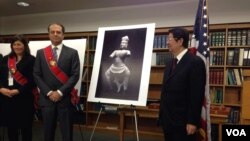NEW YORK —
Cambodia has officially received two 10th Century artifacts looted from the country more than four decades ago.
One statue the US attorney in New York forced Sotheby’s auction house to return. The second was voluntarily returned to Cambodia by Christie’s auction house.
“The Royal Government of Cambodia appeals to all museums and art collectors around the world to follow the examples of returning plundered treasure to their rightful owners as part of the worldwide campaign for the protection of cultural heritage,” Cabinet Minister Sok An said this week at a ceremony in New York to mark the antiquities’ return.
The Sotheby’s statue, called a Duryodhana, was reportedly stolen from the Prasat Chen temple of Koh Ker in 1972. The New York-based company tried to put it up for auction in 2011, but it was pulled at the last minute after a protest from the Cambodian government. The US attorney initiated a case, leading to a settlement in late 2013.
“Everyone who collects and curates and cares about art needs to be a part of the solution, not the problem,” Preet Bharara, US Attorney for the Southern District of New York, said this week. He called on people in the art world to be vigilant and “support doing what’s right when it comes to reuniting stolen artifacts with their rightful owners.”
The case against Sotheby's led to the Norton Simon Museum, in Pasadena, California, to agree to a voluntary return of a statue on display there, as well.
George Papagiannis, a Unesco external relations officer, said such moves demonstrate the “contagious” effect of antiquities returns, and he called on others to follow suit.
Cambodia’s statues are slated to arrive in the country in early June.
One statue the US attorney in New York forced Sotheby’s auction house to return. The second was voluntarily returned to Cambodia by Christie’s auction house.
“The Royal Government of Cambodia appeals to all museums and art collectors around the world to follow the examples of returning plundered treasure to their rightful owners as part of the worldwide campaign for the protection of cultural heritage,” Cabinet Minister Sok An said this week at a ceremony in New York to mark the antiquities’ return.
The Sotheby’s statue, called a Duryodhana, was reportedly stolen from the Prasat Chen temple of Koh Ker in 1972. The New York-based company tried to put it up for auction in 2011, but it was pulled at the last minute after a protest from the Cambodian government. The US attorney initiated a case, leading to a settlement in late 2013.
“Everyone who collects and curates and cares about art needs to be a part of the solution, not the problem,” Preet Bharara, US Attorney for the Southern District of New York, said this week. He called on people in the art world to be vigilant and “support doing what’s right when it comes to reuniting stolen artifacts with their rightful owners.”
The case against Sotheby's led to the Norton Simon Museum, in Pasadena, California, to agree to a voluntary return of a statue on display there, as well.
George Papagiannis, a Unesco external relations officer, said such moves demonstrate the “contagious” effect of antiquities returns, and he called on others to follow suit.
Cambodia’s statues are slated to arrive in the country in early June.







